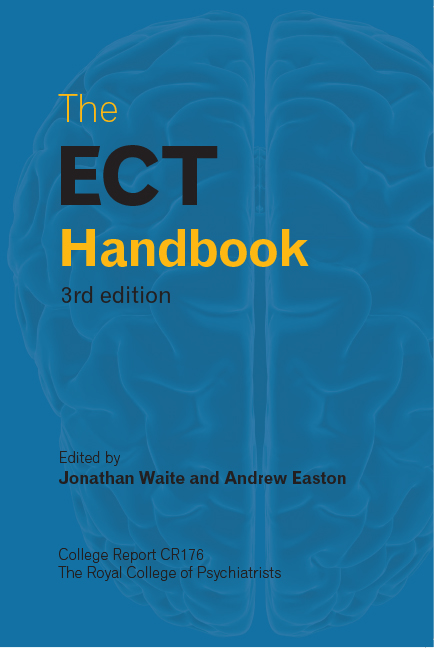Book contents
- Frontmatter
- Contents
- Abbreviations
- List of figures, tables and boxes
- List of contributors
- Preface
- Introduction: the role of ECT in contemporary psychiatry: Royal College of Psychiatrists’ Special Committee on ECT and Related Treatments
- 1 Mechanism of action of ECT
- 2 The ECT suite
- 3 Anaesthesia for ECT
- 4 ECT prescribing and practice
- 5 Psychotropic drug treatment during and after ECT
- 6 Monitoring a course of ECT
- 7 Non-cognitive adverse effects of ECT
- 8 Cognitive adverse effects of ECT
- 9 Dental issues related to ECT
- 10 Training, supervision and professional development: achieving competency
- 11 Nursing guidelines for ECT
- 12 Inspection of ECT clinics
- 13 Other brain stimulation treatments
- 14 The use of ECT in the treatment of depression
- 15 The use of ECT in the treatment of mania
- 16 The use of ECT in the treatment of schizophrenia and catatonia
- 17 The use of ECT in neuropsychiatric disorders
- 18 The use of ECT in people with intellectual disability
- 19 Safe ECT practice in people with a physical illness
- 20 ECT for older adults
- 21 The use of ECT as continuation or maintenance treatment
- 22 Consent, capacity and the law
- 23 Patients’ and carers’ perspectives on ECT
- Appendix I Out-patient declaration form
- Appendix II ECT competencies for doctors
- Appendix III Example of a job description for an ECT nurse specialist
- Appendix IV Example of a job description for an ECT nurse/ECT coordinator
- Appendix V Information for patients and carers
- Appendix VI Example of a consent form
- Appendix VII Useful contacts
- Appendix VIII Example of a certificate of incapacity
- Index
20 - ECT for older adults
- Frontmatter
- Contents
- Abbreviations
- List of figures, tables and boxes
- List of contributors
- Preface
- Introduction: the role of ECT in contemporary psychiatry: Royal College of Psychiatrists’ Special Committee on ECT and Related Treatments
- 1 Mechanism of action of ECT
- 2 The ECT suite
- 3 Anaesthesia for ECT
- 4 ECT prescribing and practice
- 5 Psychotropic drug treatment during and after ECT
- 6 Monitoring a course of ECT
- 7 Non-cognitive adverse effects of ECT
- 8 Cognitive adverse effects of ECT
- 9 Dental issues related to ECT
- 10 Training, supervision and professional development: achieving competency
- 11 Nursing guidelines for ECT
- 12 Inspection of ECT clinics
- 13 Other brain stimulation treatments
- 14 The use of ECT in the treatment of depression
- 15 The use of ECT in the treatment of mania
- 16 The use of ECT in the treatment of schizophrenia and catatonia
- 17 The use of ECT in neuropsychiatric disorders
- 18 The use of ECT in people with intellectual disability
- 19 Safe ECT practice in people with a physical illness
- 20 ECT for older adults
- 21 The use of ECT as continuation or maintenance treatment
- 22 Consent, capacity and the law
- 23 Patients’ and carers’ perspectives on ECT
- Appendix I Out-patient declaration form
- Appendix II ECT competencies for doctors
- Appendix III Example of a job description for an ECT nurse specialist
- Appendix IV Example of a job description for an ECT nurse/ECT coordinator
- Appendix V Information for patients and carers
- Appendix VI Example of a consent form
- Appendix VII Useful contacts
- Appendix VIII Example of a certificate of incapacity
- Index
Summary
A survey of old age psychiatrists in the early 1990s found that they regarded the main indication for ECT in older people to be severe depressive illness (Benbow, 1991), but they also rated the treatment as often or sometimes useful in schizoaffective disorder and depressive illness with dementia. Similarly, ECT was regarded as the treatment of choice for people with depressive illness:
• that has failed to respond to antidepressant drugs
• in which previous episodes responded to ECT but not to antidepressant Drugs
• with psychotic symptoms
• with severe agitation and those with high suicidal risk.
These clinical views are compatible with literature reporting favourable outcomes for older people treated with ECT (Damm et al, 2010) and for depressive psychosis (Birkenhager et al, 2004). Van der Wurff et al (2003) reviewed efficacy in older adults and found immediate response rates of between 55% and 85% in 10 naturalistic prospective studies and immediate response rates ranging from 48% complete recovery to 92% improvement in 14 retrospective studies. They concluded that immediate response rates are ‘impressive’, although based on non-randomised evidence. Many studies have reported response rates of around 70% or more among older adults (Fraser & Glass, 1980; Gaspar & Samarasinghe, 1982; Karlinsky & Shulman, 1984; Benbow, 1987; Godber et al, 1987; Rubin et al, 1991; Casey & Davies, 1996; Tomac et al, 1997).
The NICE (2003: p. 5) technology appraisal of ECT recommends that ECT only be used ‘to achieve rapid and short-term improvement of severe symptoms after an adequate trial of other treatment options has proven ineffective and/or when the condition is considered to be life-threatening, in individuals with:
• severe depressive illness
• catatonia
• a prolonged or severe manic episode.’
The technology appraisal was reviewed in May 2010: the recommendations on ECT in catatonia and mania were unchanged, and guidance on ECT in depression has been updated by the clinical guideline CG90 (National Institute for Health and Excellence, 2009), which states that ‘the risks associated with ECT may be greater in older people; exercise particular caution when considering ECT treatment in this group’ (p. 41). This is in the context of evidence that older people have been major users of ECT services in the past (Pippard & Ellam, 1981; Duffett et al, 1999).
- Type
- Chapter
- Information
- The ECT Handbook , pp. 191 - 195Publisher: Royal College of PsychiatristsFirst published in: 2017



